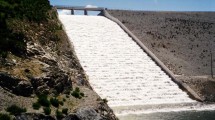Abstract
In order to pass surplus water and inundation from upstream to downstream of dams, structure called spillway is used. Spillway and chutes are among important hydraulic structures which play a significant role in stability of dams. In some cases and when the slope is too steep to build a chute, in order to transfer water from upstream to downstream, a stepped spillway which is remarkably effective in energy dissipation is used. In the present study, in order to ascertain the effect of different parameters such as number of steps (N s ), step height (h), step length (L), and discharge in width unit (q) on energy dissipation in the simple stepped spillway, the model of Flow-3D was used, and the relationship between energy dissipation and flow critical depth in the stepped spillway was investigated. Further, the method of finite volume was used to solve the extant equations, and the model of K − ɛ was also used to investigate the flow turbulence. The results revealed that as the flow discharge increases, energy dissipation decreases and as the number of steps increases and their height decreases, energy dissipation decreases. Besides, the obtained findings were compared with the other researchers, empirical and mathematical studies and finally an acceptable coincidence was obtained.
Similar content being viewed by others
References
Chamani M.R., Rajaratnam N.: Characteristics of skimming flow over stepped spillways. J. Hydraul. Eng. ASCE 125(4), 361–368 (1999)
Chen Q., Dai G., Liu H.: Volume of fluid model for turbulence numerical simulation of stepped spillway overflow. J. Hydraul. Eng. ASCE 128(7), 683–688 (2002)
Tabbara M., Chatila J., Awwad R.: Computational simulation of flow over stepped spillways. J. Comput. Struct. 83(27), 2215–2224 (2005)
Chinnarasi C., Wongwisess S.: Flow patterns and energy dissipation over various stepped chutes. J. Irrig. Drain. Eng. ASCE 132(1), 70–76 (2006)
Varjavand, P.; Khosrovinia, P.; Salmasi F.: Investigation the energy dissipation in the stepped spillway using the fluent numerical model. M.Sc, Tabriz University (2008)
Carosi G., Chanson H.: Turbulence characteristics in skimming flows on stepped spillways. Can. J. Civ. Eng. 35(9), 865–880 (2008)
Carvalho R., Martins R.: Stepped spillway with hydraulic jumps: application of a numerical model to a scale model of a conceptual prototype. J. Hydraul. Eng. ASCE 135(7), 615–619 (2009)
Hanbay D., Baylar A., Batan M.: Prediction of aeration efficiency on stepped cascades by using least square support vector machines. Express Syst. Appl. 36(3), 4248–4252 (2009)
Bombardelli F.A., Meireles I., Matos J.: Laboratory measurements and multi-block numerical simulations of the mean flow and turbulence in the non-aerated skimming flow region of steep stepped spillways. Environ. Fluid Mech. 11(3), 263–288 (2011)
Dastgheib, A.; Niksokhan, M.; Nowroozpour, A.: Comparing of flow pattern and energy dissipation over different forms of stepped spillway. In: World Environmental and Water Resources Congress (ASCE), pp. 1246–1259 (2012)
Felder S., Chanson H.: Aeration, flow instabilities, and residual energy on pooled stepped spillways of embankment dams. J. Irrig. Drain. Eng. ASCE 139(10), 880–887 (2013)
Estrella S., Sánchez-Juny M., Bladé E., Dolz J.: Physical modeling of a stepped spillway without sidewalls. Can. J. Civ. Eng. 42(5), 311–318 (2015)
Gonzalez, C.A.: An experimental study of free surface aeration on embankment stepped chutes. PhD Thesis, Department of Civil Engineering, University of Queensland, Australia (2005)
Flow Science, Incorporated: FLOW-3D Users Manual Version 9.3. Santa Fe, New Mexico (2008)
Hirt, C.W.; Sicilian, J.M.: A porosity technique for the definition of obstacles in rectangular cell meshes. In: Fourth International Conference Ship Hydrodynamics, Washington, DC, September 1985 (1985)
Hirt C.W., Nichols B.D.: Volume of fluid (VOF) method for the dynamics of free boundaries. JCP 39, 201 (1981)
Felder S., Chanson H.: Energy dissipation down a stepped spillway with nonuniform step heights. J. Hydraul. Eng. ASCE 137(11), 1543–1548 (2011)
Ruck B., Makiola B.: Particle dispersion in a single-sided buck ward-facing step flow. J. Multiph. Flow 14(6), 787–800 (1998)
Boes R.M., Hager W.H.: Two-phase flow characteristics of stepped spillways. J. Hydraul. Eng. ASCE 129(9), 661–670 (2003)
Chanson, H.: Hydraulic Design of Stepped Cascades, Channels, Weirs and Spillways. Pergamon, Oxford, 292 pp. (1995)
Author information
Authors and Affiliations
Corresponding author
Rights and permissions
About this article
Cite this article
Mohammad Rezapour Tabari, M., Tavakoli, S. Effects of Stepped Spillway Geometry on Flow Pattern and Energy Dissipation. Arab J Sci Eng 41, 1215–1224 (2016). https://doi.org/10.1007/s13369-015-1874-8
Received:
Accepted:
Published:
Issue Date:
DOI: https://doi.org/10.1007/s13369-015-1874-8




